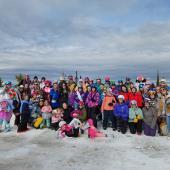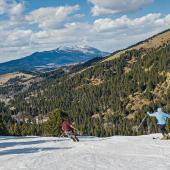Built to Survive
Profiling Bozeman-based Seneca Skis.
“It’s important that skiing survives.”
So says Eric Newman, 31-year-old owner and founder of Seneca Skis. Newman himself almost didn’t survive, coming up short on a 75-foot ski jump on the Freeskiing World Tour in 2007. After shaking off a triple-broken spine, broken neck, and broken sternum (and a doctor’s proclamation that he’d never ski again), Newman started handcrafting sustainable skis as Seneca Skis (and skiing again) in 2008.
Seneca’s first pair of skis didn’t survive either, bursting into flames in the press. “I’ve learned a lot since then,” admits Newman. Slight understatement: obsessed with ski building, Newman stole his college buddies’ engineering textbooks and stayed up until 3am nightly teaching himself calculus and physics to refine his ski-creation process. Now, almost a decade later, he ruminates over precise temperatures in the ski press, exact ratios on his ski-building algorithm, and designing skis to the closest millimeter.
That millimeter makes all the difference for Seneca. While many “custom” ski companies combine a limited number of set geometry options into a bespoke build, Seneca considers that a semi-custom ski. Their fully-custom ski option is designed millimeter by millimeter for each skier, based on Newman’s proprietary algorithm and refined through one-on-one discussion. These custom skis are created from scratch in the shop, from fresh molds and even specially ordered materials if needed. In addition to fully custom builds, Seneca designs semi-custom skis, as well as keeping three signature skis in stock.
For Newman, it all comes back to skiing’s survival. With winter sports threatened by rising temperatures globally, Newman considers sustainable building practices a must. Many of Seneca’s sustainable decisions are little things the public never hears about, such as using one of the few bio-based epoxies in the industry. Or they’re obvious—like manufacturing in an American ski town, so fewer skis have to be shipped. But the standout piece is Seneca’s wooden construction, from hand-selected Forest Stewardship Council-certified hardwoods grown in the USA.
While the wooden construction makes the skis more biodegradable, Seneca skis dodge that destiny as long as possible. They’re made to survive, too, with materials like bulletproof Kevlar, the same fiberglass that NASA uses, and Boeing Dreamliner-worthy carbon fiber. Standard processes like sublimating graphics, strategically layering the wood core, and doubling the amount of fiberglass under the binding add up to bomber construction that can take a Bozeman-style beating. In 700 pairs, not a single Seneca has delaminated.
If a ski does get a little banged up, Seneca can repair and tune it, sending it back to the slopes instead of to the dump. Seneca shares tuning equipment with Pepi Culver, former ski technician for the US Ski Team (and current Norwegian Ski Team tuner). This means sharing a P-tex gun that cost $5,000 and a stone grinder that gets re-patterned annually.
These are details you drag out of Newman—he’s not a bragger. He’s quick to switch the topic to skiers instead. “Here’s what it’s all about: I love skiing. If I can improve someone’s experience, in the shop and on the hill, and create one more happy skier, that is the whole point of what I do.”
Because in the end, it’s skiers who will help skiing survive.
To tour the shop, visit senecaskis.com or call 577-8300.















